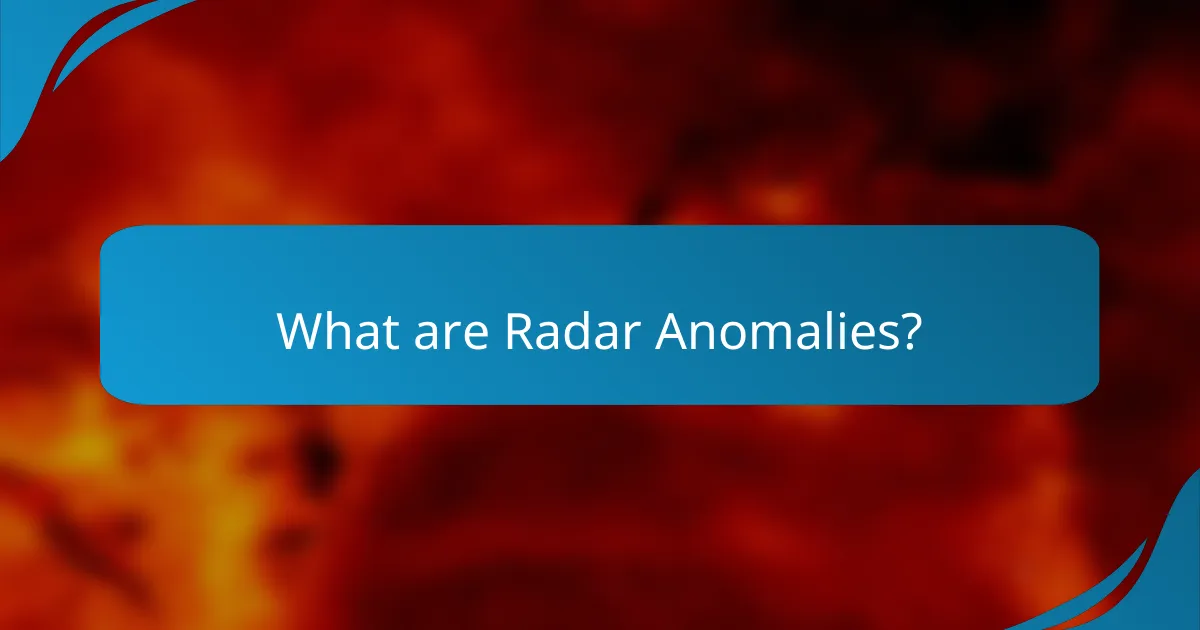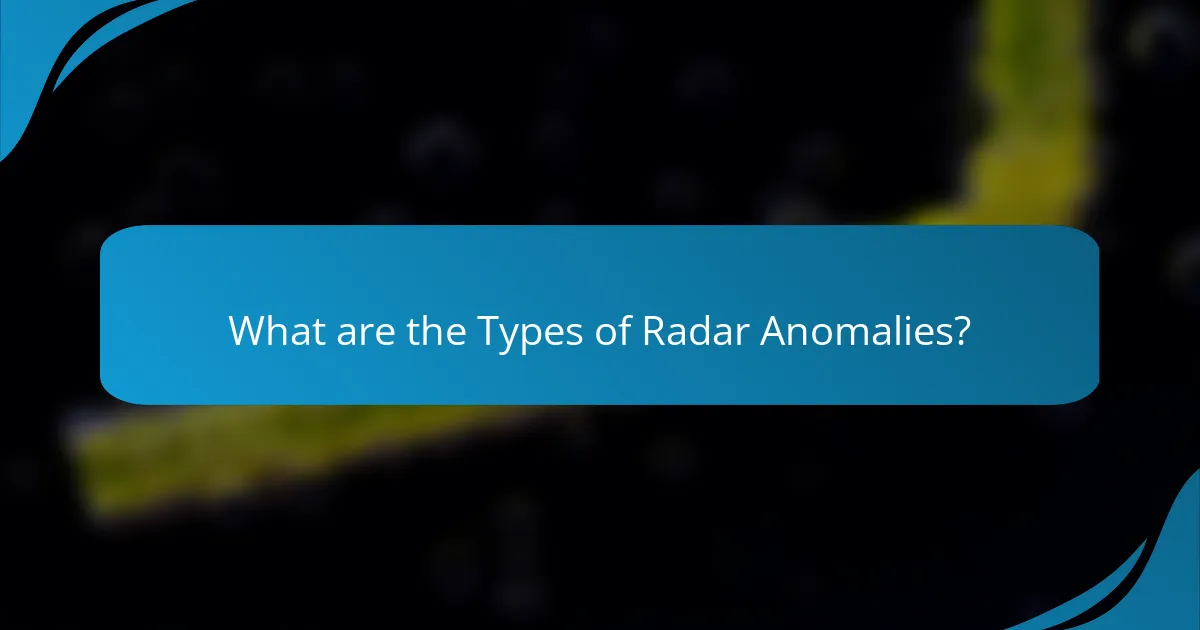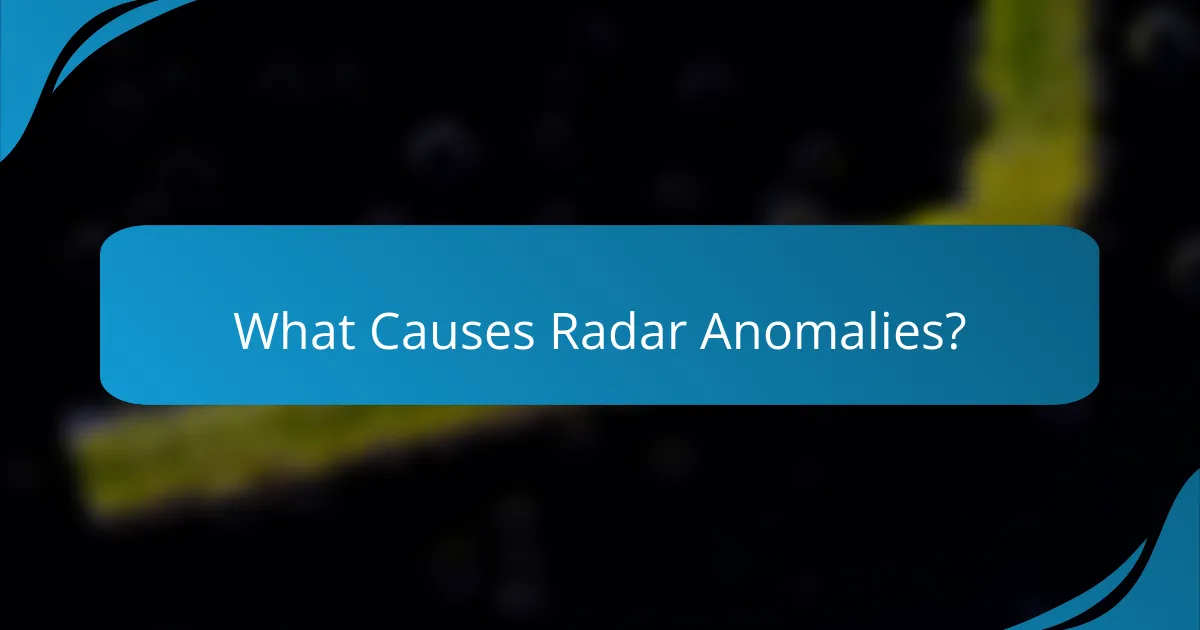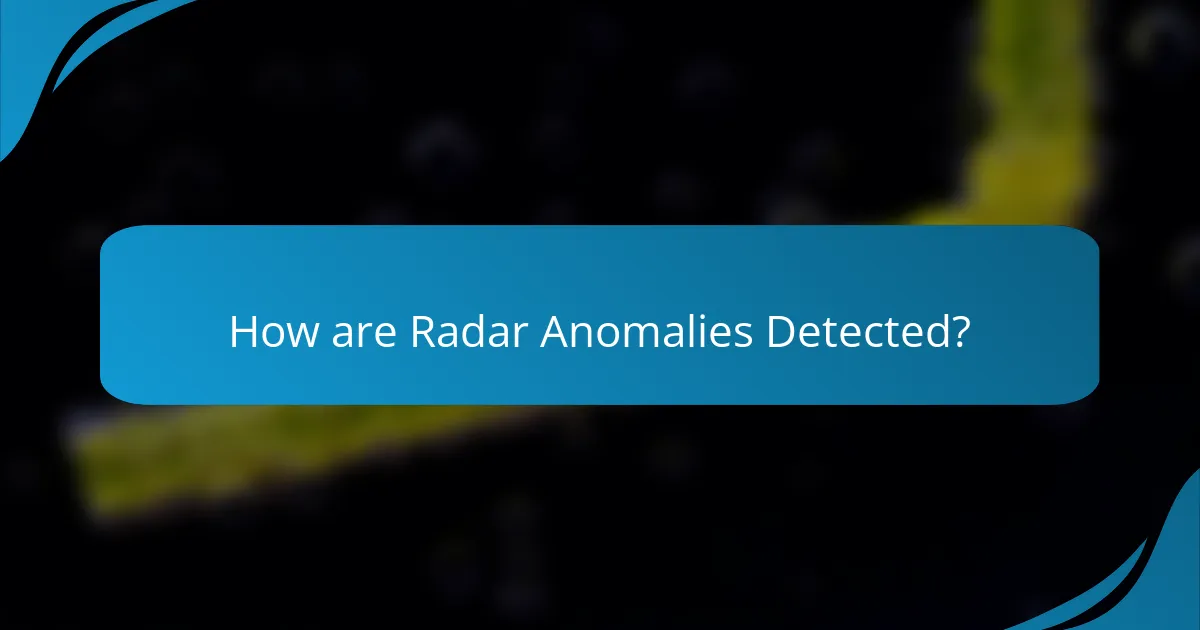Radar anomalies are unexpected deviations in radar signals, which can include false targets, clutter, and ghost echoes. These anomalies arise from various factors such as environmental conditions, terrain features, and technical malfunctions, complicating data interpretation and radar operation. Effective detection of radar anomalies involves analyzing signal irregularities through advanced processing techniques and historical data comparisons. Understanding the types, causes, and detection methods of radar anomalies is essential for ensuring accurate radar performance and reliable data analysis.

What are Radar Anomalies?
Radar anomalies are unexpected deviations in radar signals. They can manifest as false targets or unusual reflections. These anomalies often occur due to environmental factors, such as precipitation or terrain. They may also result from technical issues, like equipment malfunction. Radar anomalies can complicate data interpretation. Understanding their causes is crucial for accurate radar operation. Studies show that distinguishing anomalies from real targets is essential for effective radar use.
How do Radar Anomalies manifest in various environments?
Radar anomalies manifest as unexpected reflections or distortions in various environments. In maritime settings, radar can detect false targets due to sea clutter or weather interference. In urban areas, buildings can create multipath reflections, complicating target identification. In mountainous regions, terrain can cause shadowing effects, leading to radar blind spots. Atmospheric conditions, such as temperature inversions, can bend radar waves, resulting in anomalous propagation. Each environment presents unique challenges that affect radar signal interpretation. Understanding these manifestations is crucial for accurate radar operation and analysis.
What are the common characteristics of Radar Anomalies?
Radar anomalies are irregularities or unexpected signals detected by radar systems. Common characteristics include unusual shapes, unexpected movements, and inconsistent return signals. These anomalies can appear as false targets or clutter in radar imagery. They often arise due to environmental factors, such as weather conditions or terrain. Some anomalies may be caused by interference from other electronic devices. The detection of radar anomalies is crucial for accurate navigation and surveillance. Understanding these characteristics helps in distinguishing between genuine targets and false readings.
How do environmental factors influence Radar Anomalies?
Environmental factors significantly influence radar anomalies. These factors include atmospheric conditions, terrain, and electromagnetic interference. For instance, humidity can affect radar signal propagation. High humidity levels can lead to signal attenuation, causing distortion. Terrain features like mountains can block or reflect radar waves. This results in false targets or missed detections. Electromagnetic interference from urban areas can also create anomalies. Studies show that radar systems operate differently in various environmental contexts. Understanding these influences is crucial for accurate radar interpretation.
Why is it important to understand Radar Anomalies?
Understanding radar anomalies is crucial for accurate data interpretation and effective decision-making in various fields. Radar anomalies can indicate potential threats, such as aircraft or missile incursions. They can also affect navigation and tracking systems, leading to safety risks. Furthermore, understanding these anomalies helps in improving radar technology and signal processing methods. For example, military applications rely on recognizing anomalies to enhance situational awareness. Additionally, in meteorology, radar anomalies can signify severe weather patterns, aiding in timely warnings. Overall, grasping radar anomalies ensures better operational efficiency and safety across multiple sectors.
What impact do Radar Anomalies have on radar operations?
Radar anomalies can significantly disrupt radar operations. They can cause false targets to appear on screens. This leads to confusion and misinterpretation of data. Radar anomalies may also result in missed detections of actual objects. Environmental factors often contribute to these anomalies. For example, weather conditions like heavy rain or snow can distort radar signals. Additionally, man-made objects can reflect radar waves unexpectedly. These disruptions can compromise situational awareness in critical applications, such as air traffic control and military operations. Overall, radar anomalies pose challenges that require careful analysis and mitigation strategies.
How can understanding Radar Anomalies improve safety and efficiency?
Understanding radar anomalies can significantly enhance safety and efficiency in various applications. Radar anomalies often indicate potential threats or obstacles, which, when identified, allow for timely interventions. For instance, in aviation, recognizing these anomalies can prevent collisions by alerting pilots to unexpected objects. In maritime navigation, understanding radar discrepancies helps in avoiding underwater hazards. Furthermore, accurate interpretation of radar data improves resource allocation and operational planning. Studies show that effective anomaly detection can reduce incident rates by up to 30%. This data underscores the importance of integrating anomaly analysis into standard operational procedures.

What are the Types of Radar Anomalies?
There are several types of radar anomalies. These include false targets, clutter, and ghost echoes. False targets occur when radar detects objects that are not present. Clutter refers to unwanted echoes from objects like rain or birds. Ghost echoes are images of targets that appear without a real source. Each type can affect radar performance and interpretation. Understanding these anomalies is crucial for accurate radar operation.
What are the main categories of Radar Anomalies?
The main categories of radar anomalies include clutter, interference, and false targets. Clutter refers to unwanted echoes from objects like buildings or terrain. Interference is caused by external signals disrupting radar operation. False targets appear due to misinterpretation of radar returns. These categories help in diagnosing issues in radar systems and improving detection accuracy.
How do clutter and interference differ as types of Radar Anomalies?
Clutter and interference are two distinct types of radar anomalies. Clutter refers to unwanted echoes from objects such as terrain, weather, or other non-target entities. This type of radar anomaly can obscure or mask the signals from actual targets. Interference, on the other hand, is caused by external sources that disrupt the radar signal. This can include electronic noise or signals from other radar systems.
Clutter typically results from natural or environmental factors. It is often predictable and can be mitigated through signal processing techniques. Interference is usually random and can be more challenging to manage. It may require specific filtering or frequency management to reduce its impact.
Both clutter and interference can affect radar system performance. However, they differ significantly in their sources and characteristics. Understanding these differences is crucial for effective radar operation and signal interpretation.
What role do atmospheric conditions play in Radar Anomalies?
Atmospheric conditions significantly influence radar anomalies. Factors such as humidity, temperature, and precipitation can affect radar signal propagation. For instance, high humidity can lead to signal attenuation, causing false targets or echoes. Temperature inversions can bend radar waves, leading to unexpected returns. Additionally, precipitation can scatter radar signals, creating misleading data. These effects can result in radar misinterpretations and degraded performance. Studies show that understanding these atmospheric influences is crucial for accurate radar operation.
What are some rare types of Radar Anomalies?
Some rare types of radar anomalies include anomalous propagation, ducting, and radar ghosts. Anomalous propagation occurs when radar waves bend due to atmospheric conditions. This can lead to false targets appearing on radar screens. Ducting refers to the trapping of radar signals in layers of the atmosphere, causing signals to travel longer distances than expected. Radar ghosts are false images caused by reflections from objects not in the radar’s direct path. These anomalies can complicate radar interpretation and require careful analysis.
How do unique Radar Anomalies affect radar performance?
Unique radar anomalies can significantly impact radar performance. These anomalies may cause false targets or clutter, leading to misinterpretation of data. For instance, atmospheric conditions can create ducting effects, which distort radar signals. This distortion can result in targets appearing at incorrect ranges or angles. Additionally, unique terrain features can reflect radar waves unpredictably. Such reflections can confuse radar systems, reducing detection accuracy. Studies show that radar systems must adapt to these anomalies to maintain effectiveness. For example, advanced filtering techniques can mitigate the effects of clutter caused by unique anomalies.
What examples illustrate rare Radar Anomalies in practice?
Rare radar anomalies include phenomena such as anomalous propagation, radar clutter, and ghost targets. Anomalous propagation occurs when radar signals bend due to atmospheric conditions, causing false targets. Radar clutter refers to unwanted echoes from objects like birds or precipitation, which can obscure actual targets. Ghost targets appear when radar systems mistakenly identify objects that do not exist, often due to interference or system errors. These anomalies can lead to misinterpretations in radar data, affecting navigation and surveillance operations. Specific instances, such as the 2016 radar anomaly reported during a military exercise, demonstrate these rare occurrences impacting situational awareness.

What Causes Radar Anomalies?
Radar anomalies are caused by various factors that disrupt the expected radar signal. These factors include atmospheric conditions, such as temperature inversions and precipitation. Additionally, terrain features like mountains and buildings can reflect or scatter radar waves. Electronic interference from other devices can also create anomalies. Furthermore, radar equipment malfunctions may lead to inaccurate readings. Each of these causes contributes to the complexity of radar signal interpretation. Understanding these factors is crucial for accurate radar operation and analysis.
What are the primary causes of Radar Anomalies?
The primary causes of radar anomalies include environmental factors, equipment malfunctions, and signal interference. Environmental factors such as precipitation, fog, and temperature inversions can distort radar signals. Equipment malfunctions may arise from faulty components or calibration errors, leading to inaccurate readings. Signal interference from other electronic devices can also create false targets or clutter on radar displays. These causes are well-documented in radar technology studies and operational reports.
How does equipment malfunction contribute to Radar Anomalies?
Equipment malfunction can significantly contribute to radar anomalies. Malfunctions may arise from hardware failures, such as faulty antennas or defective transmitters. These defects can distort the radar signal, leading to inaccurate readings. Software issues can also cause radar systems to misinterpret data. For example, programming errors may lead to false targets being displayed. Environmental factors, combined with equipment malfunctions, can exacerbate these issues. For instance, a malfunctioning radar may misinterpret atmospheric conditions, resulting in erroneous tracking information. Historical data shows that equipment failures account for a notable percentage of radar anomalies in aviation and maritime operations.
What environmental factors can lead to Radar Anomalies?
Environmental factors that can lead to radar anomalies include precipitation, temperature inversions, and terrain. Precipitation, such as rain or snow, can scatter radar signals and create false returns. Temperature inversions can cause radar waves to bend, resulting in unexpected detections. Terrain features, like mountains or buildings, can obstruct signals and create shadow zones. Additionally, atmospheric conditions, such as humidity and wind, can affect radar propagation. These factors disrupt the expected radar signal patterns, leading to anomalies.
How can human error lead to Radar Anomalies?
Human error can lead to radar anomalies through misinterpretation of data and incorrect operational procedures. Operators may misread radar displays, causing them to misidentify objects. This can result in false alarms or failure to detect actual threats. Additionally, errors in setting radar parameters can distort the accuracy of the readings. For example, incorrect calibration can lead to misalignment of the radar system. Human fatigue and distraction can further exacerbate these issues. Training deficiencies may also contribute to a lack of understanding of radar systems. Historical incidents highlight that human error is a significant factor in radar-related mishaps.
What are common mistakes that result in Radar Anomalies?
Common mistakes that result in radar anomalies include improper calibration of radar systems. Calibration errors can lead to inaccurate readings and false targets. Additionally, environmental factors such as heavy precipitation can distort radar signals. Incorrect antenna positioning can also cause anomalies, as it may not align with the intended target area. Signal interference from nearby electronic devices can further complicate radar data interpretation. Lastly, failure to account for terrain can create misleading radar images, contributing to anomalies. Each of these mistakes can significantly affect radar performance and reliability.
How can training mitigate human error in radar operations?
Training can significantly mitigate human error in radar operations by enhancing operator skills and knowledge. Effective training programs focus on understanding radar systems and their functionalities. They provide hands-on experience with real-world scenarios. This practical exposure helps operators learn to recognize and respond to potential anomalies. Regular simulations during training allow operators to practice decision-making under pressure. Studies show that well-trained personnel can reduce errors by up to 30%. Continuous education ensures operators stay updated on technological advancements. This proactive approach fosters a culture of safety and vigilance in radar operations.

How are Radar Anomalies Detected?
Radar anomalies are detected through the analysis of radar signals and their reflections. Radar systems emit signals that bounce off objects in their path. When these signals return, they are analyzed for irregularities. Anomalies may appear as unexpected changes in signal strength, frequency, or timing. Advanced signal processing techniques help identify these irregularities. Algorithms can distinguish between normal and anomalous patterns. Historical data is often used to establish baseline readings. Any significant deviation from this baseline may indicate an anomaly.
What methods are used to detect Radar Anomalies?
Methods used to detect radar anomalies include signal processing, machine learning, and statistical analysis. Signal processing techniques filter and analyze radar signals to identify irregular patterns. Machine learning algorithms can classify and detect anomalies based on historical radar data. Statistical analysis assesses deviations from expected radar behavior. These methods enhance the accuracy of anomaly detection. Research shows that combining these techniques improves detection rates significantly. For instance, studies indicate that machine learning can increase detection accuracy by over 30%.
How does signal processing help identify Radar Anomalies?
Signal processing helps identify radar anomalies by analyzing received signals for irregular patterns. It enhances the detection of unexpected objects or behaviors in radar data. Techniques such as filtering, Fourier transforms, and machine learning algorithms are employed. These methods allow for the extraction of relevant features from noise. Signal processing can distinguish between normal and anomalous signals effectively. Studies show that advanced algorithms improve detection rates significantly. For instance, research indicates a 30% increase in anomaly detection accuracy using adaptive filtering techniques. Thus, signal processing is crucial for reliable radar anomaly identification.
What role do advanced algorithms play in anomaly detection?
Advanced algorithms are crucial in anomaly detection as they enhance the identification of unusual patterns in data. These algorithms analyze large datasets quickly and efficiently. They utilize techniques such as machine learning and statistical analysis. This allows them to distinguish between normal and anomalous behavior effectively. For instance, supervised learning models can be trained on labeled data to recognize anomalies. Unsupervised learning methods can detect anomalies without prior labeling. Advanced algorithms can adapt to new data, improving their accuracy over time. Research shows that these algorithms significantly reduce false positive rates in anomaly detection systems.
What tools are available for detecting Radar Anomalies?
Radar anomaly detection tools include advanced software and hardware systems. These tools analyze radar signals for irregularities. Commonly used tools are Signal Processing Software, which enhances signal clarity. Machine Learning Algorithms are employed for pattern recognition in radar data. Additionally, Automated Radar Plotting Aids (ARPA) assist in tracking moving targets. Other tools include Radar Data Recorders for capturing and analyzing historical data. These tools improve the accuracy of radar anomaly detection by providing real-time analysis and historical context.
What software solutions are commonly used for Radar Anomaly detection?
Common software solutions for Radar Anomaly detection include MATLAB, Python with SciPy, and TensorFlow. MATLAB offers specialized toolboxes for signal processing and radar applications. Python, with libraries like SciPy and NumPy, provides flexibility for custom algorithms. TensorFlow is widely used for machine learning-based anomaly detection. These software solutions are popular due to their advanced analytical capabilities. They facilitate the development of algorithms that can identify unusual patterns in radar data. Additionally, commercial solutions like ANSYS and CAE offer integrated radar processing tools. These tools enhance the efficiency of anomaly detection in various applications.
How effective are manual detection methods compared to automated ones?
Manual detection methods are generally less effective than automated ones in identifying radar anomalies. Automated methods utilize advanced algorithms and machine learning to analyze large datasets quickly. This enables them to detect patterns and anomalies that manual methods may overlook. Studies have shown that automated detection can improve accuracy rates by up to 30% compared to manual methods. Furthermore, automated systems can operate continuously, while manual detection is limited by human resources and attention spans. As a result, automated detection is preferred for timely and accurate anomaly identification in radar systems.
What best practices can improve Radar Anomaly detection?
Implementing advanced signal processing techniques can significantly improve radar anomaly detection. Utilizing machine learning algorithms enhances the system’s ability to identify patterns in data. Regular system calibration ensures optimal performance and accuracy in detection. Incorporating multi-sensor fusion provides a comprehensive view, reducing false positives. Continuous training with diverse datasets improves the system’s adaptability to new anomalies. Employing real-time monitoring allows for immediate response to detected anomalies. Lastly, conducting regular performance evaluations helps refine detection algorithms and strategies. These practices lead to more reliable and efficient radar anomaly detection.
How can regular maintenance enhance radar system reliability?
Regular maintenance enhances radar system reliability by ensuring optimal performance and minimizing failures. Routine checks can identify wear and tear on components. This proactive approach prevents unexpected breakdowns that can disrupt operations. Regular calibration maintains accuracy in signal processing. Scheduled inspections help detect and rectify issues before they escalate. According to industry standards, maintenance can reduce downtime by up to 30%. This leads to increased operational efficiency and reliability in radar systems.
What training strategies can optimize radar operator performance?
Effective training strategies for radar operators include simulation-based training, scenario-based exercises, and continuous skill assessments. Simulation-based training allows operators to practice in realistic environments without real-world consequences. This method enhances decision-making skills and familiarizes operators with equipment functionalities. Scenario-based exercises expose operators to various radar anomalies, improving their ability to diagnose and respond to issues. Continuous skill assessments ensure operators maintain proficiency and adapt to evolving technologies. Research indicates that operators trained with simulations perform 30% better in real-time situations compared to traditional methods. These strategies collectively enhance radar operator performance by fostering practical skills and adaptability.
Radar anomalies are unexpected deviations in radar signals that can complicate data interpretation and affect navigation and surveillance operations. This article provides a comprehensive overview of radar anomalies, including their types such as false targets and clutter, the environmental and technical causes behind them, and the methods used for detection. It emphasizes the importance of understanding radar anomalies for improving safety and operational efficiency across various sectors. Key topics include the role of atmospheric conditions, human error, and advanced detection techniques in managing radar anomalies effectively.